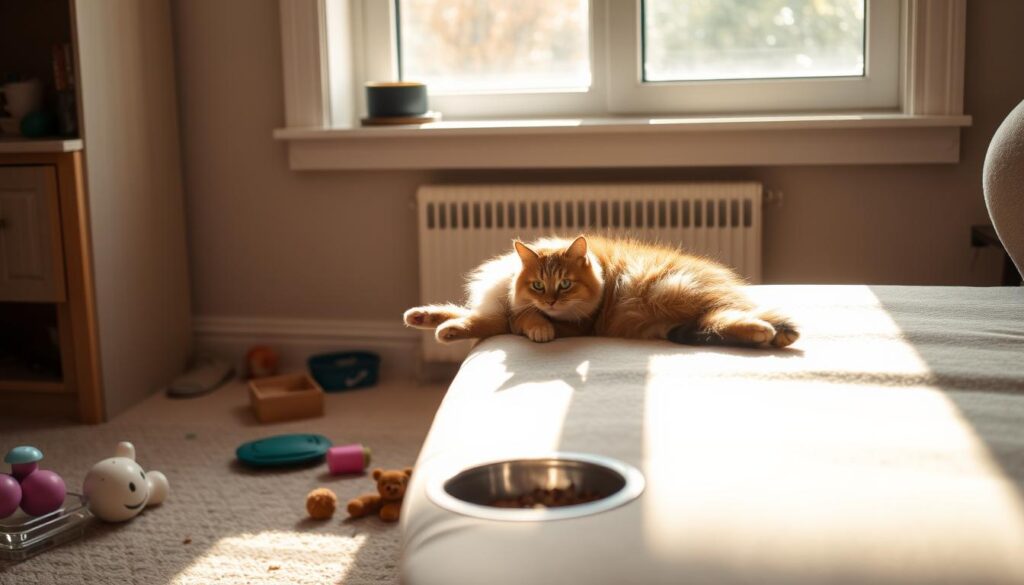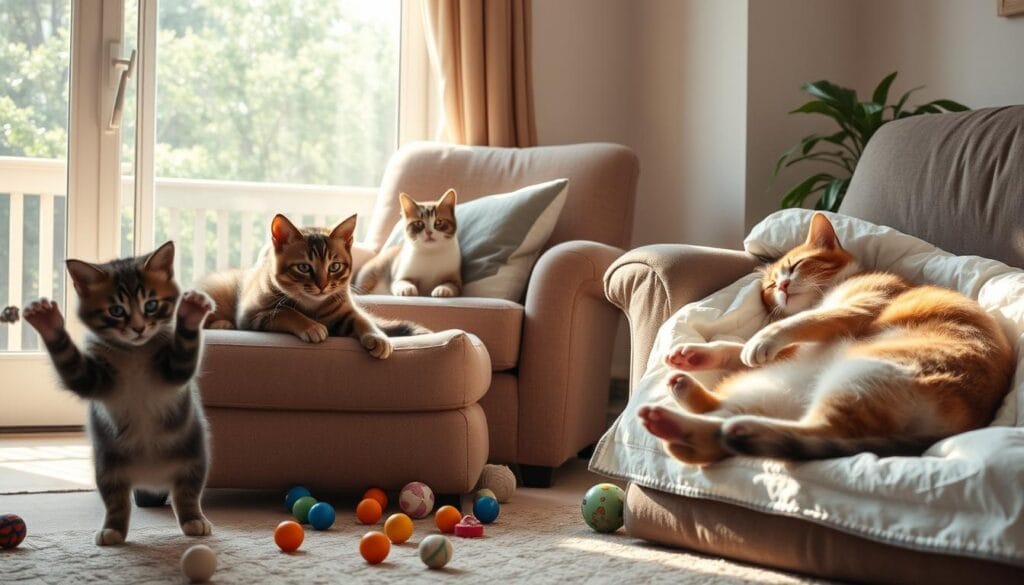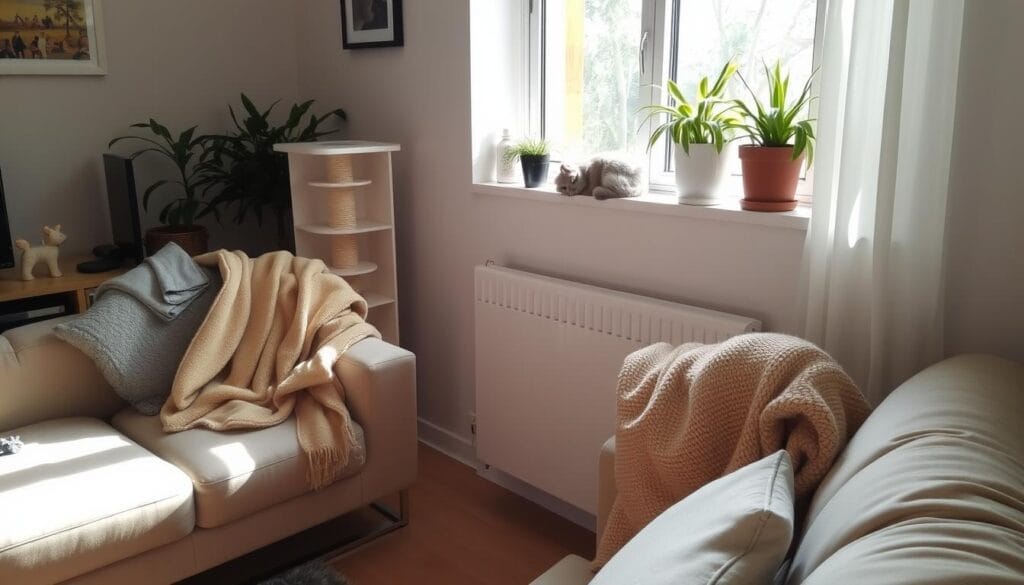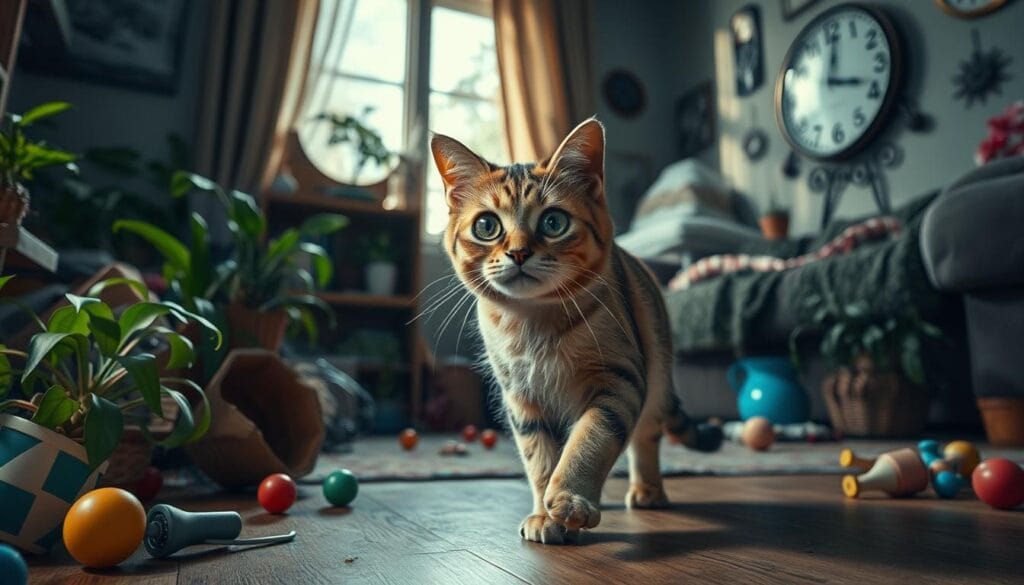Cats are beloved companions with unique needs. It’s important to know how long you can leave them alone safely. The time depends on their age, health, and personality. (Cat Alone)
Cats are social and need interaction and stimulation. They may seem independent but can feel stressed and anxious when left alone for too long. It’s crucial to meet their needs, whether you’re home or away, for their happiness and health.

Key Takeaways
- Cats have specific needs that must be considered when leaving them alone at home
- The length of time a cat can be left alone depends on factors such as age, health, and individual personality
- Cats are social creatures that can experience stress and anxiety when left alone for too long
- Proper preparation and consideration of your cat’s needs are essential to ensure their wellbeing
- Consulting with a veterinarian or professional can provide valuable guidance on the appropriate time to leave your cat alone
Understanding Your Cat’s Needs
As a pet parent, knowing what your cat needs is key to their happiness and health. Cats love to interact and need stimulation, whether it’s with people or other cats.
Importance of Social Interaction
Cats in single-cat homes need regular interaction to avoid boredom and anxiety. Playing, cuddling, and gentle petting meet their need for companionship. Toys, scratching posts, and other activities keep them entertained when you’re away.
Recognizing Signs of Distress
Watch for signs your cat might be feeling stressed or uncomfortable alone. Look out for loud meowing, too much grooming, not eating, accidents in the house, and aggression. These could mean your cat needs more attention or support.
Understanding your cat’s needs helps you prepare their home for when you’re not there. Making sure they have companionship and things to do keeps them happy and healthy.
“Cats are social creatures that thrive on interaction and environmental stimulation.”
Age and Health Considerations for Cats
Age and health are key when leaving your cat alone. As your cat grows, their needs and ability to handle being alone change. Knowing these changes helps you care for your cat, whether they’re young, adult, or old. (Cat Alone)
Kittens and Their Special Needs
Kittens are full of energy and curiosity. They need constant attention and interaction. Leaving a kitten alone for too long can harm their cat bonding and well-being. (Cat Alone)
They need a fun environment, regular food, and lots of play. Teaching them to be independent slowly helps them handle being alone better as they get older. (Cat Alone)
Senior Cats and Loneliness
Older cats feel loneliness more. They like familiar places and being with their owners. Leaving an older cat alone for too long can stress them out and hurt their health. (Cat Alone)
It’s important to give your senior cat lots of attention and a nice environment. This helps keep them happy and healthy.
| Age Group | Recommended Alone Time | Considerations |
|---|---|---|
| Kittens (under 1 year) | No more than 4 hours | Require frequent interaction, play, and supervision |
| Adult Cats (1-10 years) | 4-8 hours | Can generally handle longer periods of solitude |
| Senior Cats (over 10 years) | 4 hours or less | More sensitive to loneliness and may require additional companionship |

These are just general tips. Each cat is different, based on their personality, health, and surroundings. Talk to your vet to find the best way to care for your cat when they’re alone. (Cat Alone)
General Guidelines for Leaving Cats Alone
Cats and dogs are different when it comes to being alone. Cats have limits to how long they can stay by themselves. Knowing these limits is key to keeping your cat happy and healthy. (Cat Alone)
Safe Timeframes for Cat Loneliness
Most adult cats can handle being alone for 8-12 hours. But, this can change based on your cat’s age, health, and personality. Kittens and older cats need more attention and shouldn’t be left alone for too long. (Cat Alone)
Factors That Influence Alone Time
- Age: Kittens and senior cats need more companionship and supervision.
- Health: Cats with medical conditions or special needs may become distressed when left alone.
- Personality: Some cats are more independent and can tolerate feline solitude better than others.
- Environment: A stimulating, cat-proofed environment can help mitigate the effects of cat alone time.
- Previous Experiences: Cats with a history of abandonment or neglect may have more difficulty coping with lonely pet situations.
Cats are social animals and need companionship. This can be from humans or other cats. By understanding your cat’s needs and creating a safe, enriching space, you can ensure they’re happy and healthy, even when they’re alone.
| Cat Age | Recommended Alone Time |
|---|---|
| Kitten (under 1 year) | 4 hours or less |
| Adult (1-7 years) | 8-12 hours |
| Senior (8+ years) | 6 hours or less |
Preparing Your Home for a Cat Alone
As a responsible pet owner, it’s key to prepare your home for your cat’s alone time. A stimulating environment and access to essential supplies are crucial. They help keep your cat happy and safe when you’re away. (Cat Alone)
Creating a Stimulating Environment
Set up engaging activities and toys to fight boredom. Use interactive puzzle feeders and hide-and-seek treats. Rotate new toys to keep things interesting. (Cat Alone)
Provide vertical spaces like cat trees and window perches. They let your cat climb and watch their territory.
Essential Supplies to Leave Behind
Make sure to leave enough food, water, and litter for your cat. An automatic feeder and water dispenser are great for keeping their needs met. Stock up on extra litter and a clean litter box. (Cat Alone)
Leave familiar bedding, scratching posts, and favorite toys. They help ease any separation anxiety your cat might feel.
| Item | Quantity |
|---|---|
| Dry Cat Food | 3 lbs |
| Wet Cat Food | 24 cans |
| Litter | 20 lbs |
| Water Dispenser | 1 |
| Automatic Feeder | 1 |
| Familiar Toys | 5 |
By creating a stimulating environment and providing essential supplies, your independent cat will thrive. They’ll enjoy their time alone in your single cat household. (Cat Alone)

Technology That Can Help
In today’s world, technology offers many ways to care for cats when you’re away. It lets you watch your cat’s activities and do important tasks automatically. The right tech tools can make you feel at ease and ensure your cat is well taken care of.
Cameras to Monitor Your Cat
Pet cameras are now a favorite among cat owners. They let you see what your cat is doing live, check in on them, and even talk to them. Some cameras even give treats to keep your cat happy and supported when you’re not there. (Cat Alone)
Automatic Feeders and Toys
Automatic feeders and toys are great for solo cat care. Timed feeders make sure your cat eats and drinks even when you’re not home. Smart toys that move, give treats, or make sounds keep your cat’s mind active and prevent boredom. These tools meet your cat’s physical and cat companionship needs, keeping them happy and engaged while you’re away.
Using these tech solutions in your cat alone care routine makes a safe and fun space for your cat. It gives you peace of mind and shows you’re a responsible solo cat care owner.
Signs Your Cat is Not Coping Well
As a cat owner, it’s important to notice when your cat seems upset when alone. This could be when you’re at work or out running errands. Knowing the signs of cat separation anxiety helps you act fast to prevent bigger problems. (Cat Alone)
Behavioral Changes to Watch For
Look out for these changes in your cat’s behavior:
- Excessive vocalization, such as meowing or yowling
- Increased grooming or overgrooming, which can lead to bald patches
- Destructive behaviors, like scratching furniture or chewing on household items
- Changes in sleeping patterns, either sleeping more or less than usual
- Refusal to use the litter box or inappropriate elimination
Physical Signs of Stress
Physical signs can also show that your cat is stressed. These include:
- Loss of appetite or changes in eating habits
- Digestive issues, such as vomiting or diarrhea
- Elevated heart rate or irregular breathing
- Excessive panting or drooling
- Changes in coat condition or appearance, like a dull or unkempt fur
If you see any of these cat behavior changes, act quickly. With patience and the right steps, you can help your cat feel better. This way, your cat can live a happy and healthy life. (Cat Alone)

Alternatives to Leaving Your Cat Alone
As a responsible cat owner, you might need to find ways to keep your cat company when you’re away. Life can get busy, but there are good options to keep your cat happy and healthy. These options help with cat bonding and your cat’s overall well-being.
Cat Sitters vs. Boarding Facilities
Hiring a cat sitter is a great alternative. They can visit your home and care for your cat. This keeps your cat in a familiar place, reducing stress and keeping their routine intact. You could also board your cat at a special facility. There, they get personal attention and can play with other cats.
The Benefits of Having a Feline Companion
Another option is getting a second cat. This is especially good for cats living alone. They can keep each other company and prevent boredom and loneliness. Cats are social animals and having a friend can make them feel more secure and happy.
Choosing between a cat sitter, boarding, or a second cat depends on your situation and your cat’s needs. By looking into these options, you can make sure your cat gets the care they need, even when you’re not there.
“The greatest gift you can give your cat is another cat.” – Grumpy Cat
How to Train Your Cat for Independence
As a responsible pet owner, you might need to leave your independent cat alone sometimes. But don’t worry, you can teach your cat to be okay with being alone. Here are some tips to help your cat learn to take care of itself when you’re not there.
Gradual Alone Time Training
Begin by leaving your cat alone for short periods, like 10-15 minutes. Then, slowly increase the time. This helps your cat get used to being alone without you. Make sure they have fun toys, cozy places to sleep, and enough food and water.
Positive Reinforcement Techniques
- Reward your cat with treats and praise when they act calm and independent while you’re away.
- Make leaving a positive experience by giving them a special toy or food puzzle only when you leave.
- Use pheromone diffusers or sprays to calm your cat and reduce stress when they’re alone.
By using these training methods, you can help your cat feel more independent and comfortable alone. With patience and consistency, your cat will learn to enjoy time with and without you.
When to Consult a Veterinarian
As a cat owner, knowing when to seek vet help is key. If your cat has cat separation anxiety, shows odd cat behavior, or seems upset by feline solitude, it’s time to visit the vet.
Seeking Professional Advice
Your vet can offer great advice on your cat’s needs. They can spot any health issues that might make your cat feel lonely. They’ll suggest treatments, behavior changes, and ways to reduce loneliness.
Understanding Medical Conditions Affecting Loneliness
- Separation anxiety: Cats with this may meow a lot, destroy things, or soil the house when alone.
- Age-related cognitive decline: Older cats might feel lonely and get lost or anxious when left.
- Chronic pain or illness: Cats with health problems may find it hard to relax when alone.
By teaming up with your vet, you can learn what your cat needs. Together, you can make a plan to keep them happy, even when you’re away. With the right help, your cat can do well, even when they’re alone.
| Condition | Symptoms | Recommended Action |
|---|---|---|
| Separation Anxiety | Excessive vocalization, destructive behavior, house soiling | Consult a veterinarian for behavior modification techniques and treatment options |
| Age-related Cognitive Decline | Disorientation, anxiety, changes in sleep-wake cycle | Seek veterinary advice for medications and environmental enrichment strategies |
| Chronic Pain or Illness | Lethargy, decreased appetite, changes in grooming habits | Work with your veterinarian to manage the medical condition and ensure your cat’s comfort |
Myths About Leaving Cats Alone
There are many wrong ideas about leaving cats alone. Many think independent cats do well without anyone around. But, the truth is more complex. Let’s look at the myths about lonely pet care.
Debunking Common Misconceptions
One myth is that cats don’t need much company. But studies show cats love to be around others, whether it’s people or other cats. Leaving a cat alone for too long can cause problems like meowing too much, being aggressive, and health issues.
Another myth is that independent cats can entertain themselves all day. While cats can be on their own, they still need things to do to stay happy and healthy. Without enough to do, they might get bored, stressed, or even depressed.
The Truth About Cat Solitude
The truth is, cats are different and need their own time. Some cats can handle being alone for a while, but others need more attention. Knowing what your cat likes and needs is key to their happiness.
By understanding the myths and the real needs of cat solitude, you can give your cat the best care. This way, they can enjoy being alone and also enjoy being with you.
Conclusion: Finding the Right Balance
Finding the right balance between your cat’s independence and companionship is key. Cats can handle being alone for short times. But, they need enrichment, resources, and support when you’re away.
Summary of Tips for Happy Independence
Think about your cat’s age, health, and needs when deciding how long they can be alone. Make their space fun with toys, hiding spots, and comfy places to rest. Use tech like cameras and feeders to check on them while you’re out.
Watch for signs of stress and talk to your vet if you’re worried about your cat’s solo time.
Encouragement for Cat Owners
With the right planning and creativity, you can find a balance for your cat. Focus on cat bonding, cat companionship, and solo cat care. This way, your cat will be happy and healthy, always by your side.
FAQ
How long can you leave your cat alone at home?
How long you can leave your cat alone varies. It depends on their age, health, and personality. Adult cats usually do okay for 8-12 hours alone. But, it’s key to think about your cat’s needs and make sure they’re cared for.
What are the signs that my cat is not coping well with being left alone?
If your cat starts meowing more, grooming too much, or acts destructive, they might be stressed. Physical signs like not eating, being very tired, or changes in the litter box also show stress or anxiety.
How can I prepare my home to keep my cat comfortable and entertained while I’m away?
To keep your cat happy, leave out fun toys and puzzle feeders. Make sure they have places to climb and look out the window. Also, make sure they have food, water, and a clean litter box.
What are the benefits of having a second cat as a companion?
Getting a second cat can make your first cat happier. They’ll have someone to play with and keep them company. This can help them feel less lonely and stressed when you’re away.
When should I consult a veterinarian about my cat’s ability to be left alone?
If your cat is really upset, meowing a lot, or acting out, see a vet. They can check if there’s a health or behavior issue causing the problem. This can help your cat feel better when you’re away.
IMPORTANT ADDITIONS
Edited on , 26 NOV ,2024
Read more articles : https://petsfeeling.com/blog-2/
social media :
facebook : https://www.facebook.com/PetsFeeling0/
tiktok : https://www.tiktok.com/@pets.feeling
instagram : https://www.instagram.com/pets._.feeling/
youtube : https://www.youtube.com/@Pets-Feeling

